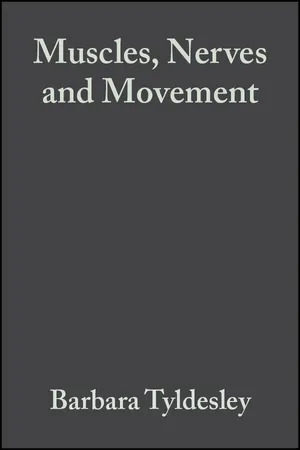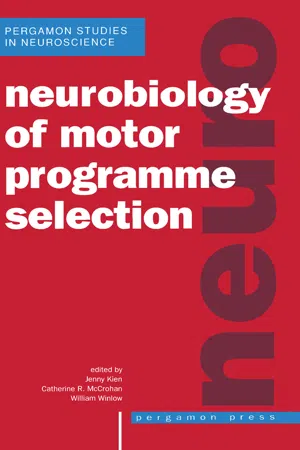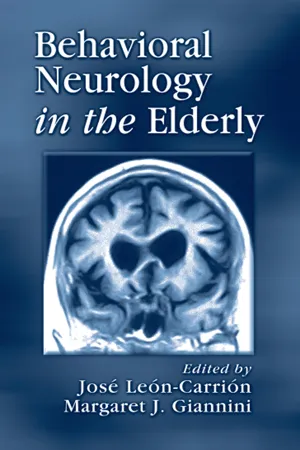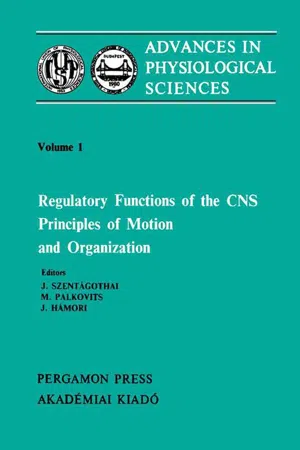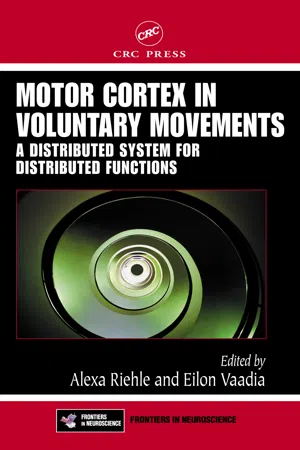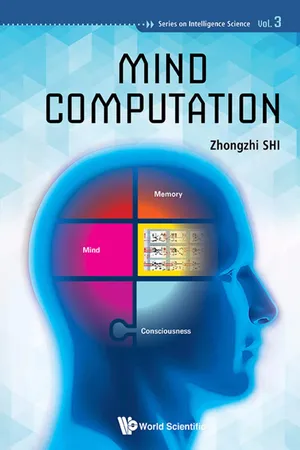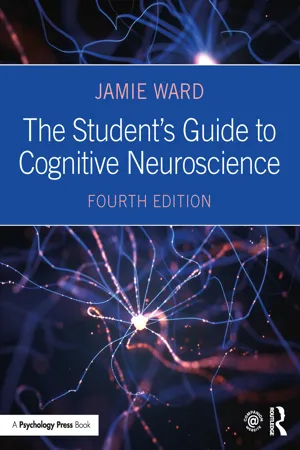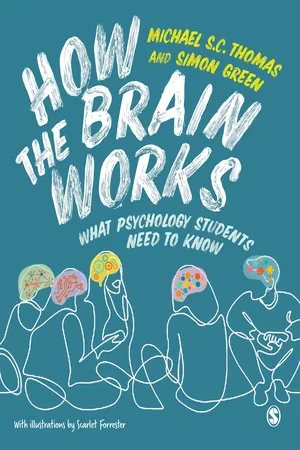Psychology
Motor Area of Brain
The motor area of the brain is a region in the cerebral cortex responsible for planning, control, and execution of voluntary movements. It is located in the frontal lobe and is divided into the primary motor cortex and the premotor cortex. The primary motor cortex directly controls muscle movements, while the premotor cortex is involved in coordinating complex movements and integrating sensory information.
Written by Perlego with AI-assistance
Related key terms
Related key terms
1 of 4
Related key terms
1 of 3
9 Key excerpts on "Motor Area of Brain"
- eBook - ePub
Muscles, Nerves and Movement
In Human Occupation
- Barbara Tyldesley, June Grieve(Authors)
- 2013(Publication Date)
- Wiley-Blackwell(Publisher)
Fig. 3.8b ). Neuroimaging studies have recorded an increase in cerebral blood flow in the supplementary motor area immediately before the execution of a complex sequence of movements of the fingers, and when both hands are involved. These studies suggest a role in the planning of movement that is internally generated.The motor speech area identified by Broca lies in the lower part of the frontal lobe in the lip of the lateral sulcus (see Fig. 3.8a ). The function of this area, usually only found in the dominant hemisphere, is in the production of fluent speech.The prefrontal area (supraorbital area) occupies the large anterior area of the frontal lobe and connects with all the other lobes of the cerebral hemispheres, the thalamus, the limbic system and many other brain areas. Interaction with the limbic system is concerned with the emotional aspects of movement. The prefrontal area is also concerned with the planning of goal-directed movement and behaviour and in modifying the plan in response to changes in the environment. These are known as the executive functions.Fig. 3.8Main functional areas of the cerebral hemispheres: (a) lateral view; (b) medial view. MC = primary motor cortex; SMA = supplementary motor area; SC = somatosensory area.Fig. 3.9Primary motor cortex seen in frontal section to show the representation of body parts.Clinical note-pad 3B: Frontal lobe lesion- Primary and premotor cortex. Lesion on one side leads to muscle weakness in the muscles of the opposite side of the body, known as hemiplegia. Muscle tone may be low (flaccid) or high (spastic). Fine skilled movements of the extremities are particularly affected.
- Prefrontal cortex. Lesions in this area lead to problems in planning movement and in reviewing it during progress. This has implications for safety. Loss of insight into movement performance may be a major factor in the poor prospect of successful rehabilitation. There may be inability to monitor social behaviour. The inability to plan and monitor movement and behaviour resulting from lesions in the prefrontal cortex is known as dysexecutive syndrome (DES).
- eBook - ePub
Neurobiology of Motor Programme Selection
New Approaches to the Study of Behavioural Choice
- J. Kien, C.R. McCrohan, W. Winlow(Authors)
- 2013(Publication Date)
- Pergamon(Publisher)
et al., 1988b), the intrinsically based selection of specific strategies or ‘motor programmes’ that are allowed to gain access to the output systems. This selectivity may be viewed as emerging through a process of competing interaction between different intentions that are attempting to activate executive motor areas. It is clear that the issue of behavioural choice, or how an organism selectively acts, relates very closely to the premotor process or how the organism selectively activates a particular motor pattern in a particular context so as to achieve a particular outcome. I will now turn to a more specific discussion of the premotor concept and to premotor systems of the human and non-human primate brain.12.2 The premotor concept
The historical development of the premotor concept has recently been reviewed by Freund and Hummelsheim (1985) . The concept of a ‘premotor’ area in the human frontal lobes can be traced to Fulton (1935) and his co-workers at Yale who drew a distinction between the ‘motor area’ of the precentral gyrus (Brodmann’s area 4) and the regions anterior to it, in particular the upper part of Brodmann’s area 6 (labelled 6aα and 6aβ by the Vogts in 1919). This distinction was not without controversy, however, since others (e.g. Walshe, 1935 ) argued that the ‘motor area’ was a continuum including both area 6 and area 4 as a single entity. Based on electrical stimulation studies in monkeys,Woolsey et al. (1952)defined the motor field of the precentral area to have a continuous epaxial structure (Kwan et al., 1978) that extended rostrally into area 6, and saw no reason to distinguish anterior area 6β as a motor association area. However, they did identify an additional separate motor field on the mesial surface of the frontal lobe anterior to the leg representation of the primary motor area corresponding to the supplementary motor area (SMA) of Penfield and Welch (1949) in humans.Woolsey et al. (1952)labelled the precentral excitable region MI and the mesial motor field MII. For recent reviews of the SMA see Wiesendanger and Wiesendanger (1984) , Goldberg (1985b) , and Wiesendanger (1986) . The SMA and the anterior cingulate cortex are adjacent to each other on the medial surface of the hemisphere and are strongly interconnected, and both areas project topographically to the primary motor cortex (Muakkassa and Strick, 1979 - eBook - ePub
- Jose Leon-Carrion, Margaret Giannini, Jose Leon-Carrion, Margaret Giannini(Authors)
- 2001(Publication Date)
- CRC Press(Publisher)
2 The performance of voluntary movements depends on the participation of several anatomical structures in the nervous system and periphery. In addition to the motor neurons, the striated muscles, the specific body parts involved in the motion, and the central nervous system (CNS) are involved in the organization of the behavior and participate in the execution of voluntary movement. This complex process requires the coactivation of motor, planning, and organizational structures together with sensory structures in the CNS. Because of the multiple components involved in the execution of voluntary movement, it is difficult to identify the cerebral structures that are exclusively responsible for motor behavior. This chapter describes the cortical and subcortical structures involved in the execution of voluntary movement, and reviews some of the current theories on motor systems.A complete review of the evolution of all motor activities is beyond the scope of this chapter. The review here is limited to human motor functions that affect activities of daily living when the quality of the movement changes. Reviewed are gait, crucial in independent functioning; swallowing and oral-motor skills because of their importance in feeding and verbal communication; studies of normal elderly subjects in the execution of upper limb movements, including manual motor skills; and the effects of aging on learning new motor skills. Finally, this chapter reviews some of the most relevant studies in apraxia, defined as a neurological disorder of learned purposive behavior movement skill that is not explained by deficits in elemental motor or sensory systems3 and describes praxis in normal elderly subjects that were used as control groups in research.7.2 ANATOMY OF MOTOR FUNCTIONS
Among the cortical structures involved in voluntary movements, the frontal cortex contains the primary motor cortex (MI), which corresponds to area 4 of Brodman, the supplementary motor area (SMA), which conforms to the lateral and medial premotor cortex in the medial part of area 6, and the premotor cortex (PM), also called the dorsal prefrontal cortex, above the frontal eye field (areas 9 and 46). The basal ganglia and the cerebellum are the two major noncortical components of the motor system.7.2.1 CORTICAL AREAS
7.2.1.1 Primary Motor Area
The neurons of the MI connect to spinal and bulbar motor neurons and receive afferent impulses from the premotor area (PM), SMA, and cerebellum. Studies in cerebral blood flow (CBF) and cerebral metabolism (CMR) show that, except for voluntary eye movements, all other types of voluntary activity of the limbs, head, and face increase regional cerebral blood flow (rCBF), regional cerebral metabolism (rCMR), or open regional calcium channels (Ca2+ ) in the somatotopical field of the MI.4 These signs of increased energy utilization of areas in MI during voluntary motor activities of the limbs is mostly contralateral, although in the early phases of motor learning small activation can appear in the ipsilateral MI areas.4 - eBook - ePub
Regulatory Functions of the CNS Principles of Motion and Organization
Proceedings of the 28th International Congress of Physiological Sciences, Budapest, 1980
- J. Szentágothai, M. Palkovits, J. Hámori(Authors)
- 2013(Publication Date)
- Pergamon(Publisher)
Neural mechanisms of voluntary movements and precentral motor areaPassage contains an image
OPENING REMARKS ON THE NEURAL MECHANISMS OF VOLUNTARY MOVEMENTS AND PRECENTRAL MOTOR AREA
C.G. Phillips, Department of Anatomy, South Park Road, Oxford OX1, EnglandPublisher Summary
This chapter presents remarks on the neural mechanisms of voluntary movements and precentral motor area. The precentral motor area has been studied extensively in primates. It lies far downstream on the pathways that project the motor output from the central nervous system. It contains corticospinal neurons in lamina V, which make monosynaptic connections with alpha motoneurons, and are thus separated by only one synapse from the neuromuscular junctions. The number of neurons contained in any radially-orientated cylinder of cortex is similar to the number contained in cylinders of equal diameter from any other area of neocortex except area 17. Between the widely spaced neurons of area 4 is a bulky neuropil that provides a richness of synaptic connectivity unequaled in other areas. In the arm area, which has been the most studied, microstimulation finds that the motor outputs to different joints of the arm, forearm, and hand are located in multiple hot spots for flexion or extension of each joint, widely scattered, and interspersed with scattered hot spots for other joints.A century ago it would have been generally supposed that the Rolandic area of the human cortex was the actual locus of initiation of voluntary movements. But in the eighteen eighties there were two dissentient voices, those of François-Franck and Sherrington. The first concluded that this area contained ‘points of departure’ and not centres for movement. The second tried, unsuccessfully, to introduce the term ‘cord area’ in order to escape the theoretical obligations of the term ‘motor area’, and to designate merely that area of the cortex which is so intimately connected with the spinal cord that cortical lesion is followed by degeneration of a spinal tract. - eBook - ePub
Motor Cortex in Voluntary Movements
A Distributed System for Distributed Functions
- Alexa Riehle, Eilon Vaadia(Authors)
- 2004(Publication Date)
- CRC Press(Publisher)
Why does the frontal lobe contain all of these premotor areas? Although there is as yet no definitive answer to this question, current data from anatomical, physiological, behavioral, and imaging studies suggest that each premotor area is concerned with a specific aspect of movement planning, preparation, and execution. Thus, the task of generating and controlling movement appears to be broken up into a number of subtasks that are accomplished through parallel distributed processing in multiple motor areas. Multiple motor areas may thereby decrease response time and increase response flexibility. In any event, the cortical control of movement is achieved by multiple motor areas, all of which send signals to the spinal cord.ACKNOWLEDGMENTS
This work was supported by the Veterans Affairs Medical Research Service, and by U.S. Public Health Service grant #24328 (PLS).REFERENCES
1 . Kuypers, H.G.J.M., Anatomy of the descending pathways, in Handbook of Physiology, Section I: The Nervous System, Vol. II: Motor Control, Part I, Brooks, V.B., Ed., American Physiological Society, Bethesda, MD, 1981, 567.2 . Wise, S.P., The primate premotor cortex fifty years after Fulton, Behav. Brain Res., 18, 79, 1985.3 . Wiesendanger, M., Recent developments in studies of the supplementary motor area of primates, Rev. Physiol. Biochem. Pharmacol., 103, 1, 1986.4 . Hepp-Reymond, M.C., Functional organization of motor cortex and its participation in voluntary movements, in Comparative Primate Biology, Vol. 4: Neurosciences, Alan R.Liss, 1988, 501.5 . Asanuma, H., The Motor Cortex, New York, Raven Press, 1989.6 . Cheney, P.D., Fetz, E.E., and Mewes, K., Neural mechanisms underlying corticospinal and rubrospinal control of limb movements, Prog. Brain Res., 87, 213, 1991.7. Georgopoulos, A., Higher order motor control, Annu. Rev. Neurosci., 14, 361, 1991.8 . Tanji, J., The supplementary motor area in the cerebral cortex, Neurosci. Res., 19, 251, 1994.9 . Dum, R.P. and Strick, P.L., The corticospinal system, a structural framework for the central control of movement, in Handbook of Physiology, Section 12: Exercise, Regulation and Integration of Multiple Systems, Rowell, L.B. and Shepard, J.T., Eds., American Physiological Society, New York, 1996, 217.10. Geyer, S. et al., Functional neuroanatomy of the primate isocortical motor system, Anat. Embryol., - eBook - ePub
- Larry Squire, Darwin Berg, Floyd E. Bloom, Sascha du Lac, Anirvan Ghosh, Nicholas C. Spitzer, Larry R. Squire, Floyd E. Bloom, Nicholas C. Spitzer(Authors)
- 2008(Publication Date)
- Academic Press(Publisher)
Axons from the cerebral cortex and from the red nucleus in the brain stem descend in pathways located dorsolaterally in the spinal cord to control voluntary movements. In addition to corticospinal and rubrospinal pathways, the motor cortex also sends projections to the red nucleus and to the pontomedullary reticular formation, providing indirect pathways for voluntary control. Multiple cortical motor areas—distinguished by their inputs, their cytoarchitecture, and their interconnections with other cortical areas and with the thalamus—make different contributions to the control of voluntary movements. The most detailed motor map is found in the primary motor cortex, M1, but the somatotopic organization is limited by convergence and divergence in the corticospinal projection. Populations of M1 neurons are also in most direct control of movement kinematics and dynamics. Other cortical motor areas participate differentially in the selection of, and preparation for, voluntary movements based on a variety of internal and external cues.SUMMARY
The motor cortex, the red nucleus, the pontomedullary reticular formation, and the vestibular nuclei each send major axonal projections descending from the brain to the spinal cord to control bodily movements. Although these pathways normally provide seamless movement control, different contributions of the medial and lateral descending pathways have been identified experimentally.The medial system—vestibulospinal and reticulospinal—receives sensory input from the vestibular apparatus and mediates postural responses that keep the head and body stabilized for stance and gait. Additional visual and proprioceptive inputs that reach the vestibular and reticular nuclei via brain stem pathways or after processing in the cerebellum (Chapter 32 ) also influence postural control. Context-dependent strategies established via centers including the cerebellum and motor cortex further adapt postural responses to the needs of particular complex situations.The lateral system—corticospinal and rubrospinal—receives, in addition to somatosensory inputs, information processed by the cerebellum (Chapter 32 ), the basal ganglia (Chapter 31 - eBook - ePub
- Zhongzhi Shi(Author)
- 2017(Publication Date)
- WSPC(Publisher)
In 1870, Fritsch and Hitzig first showed that the stimulation of some cortex of anesthetized dogs would elicit movement of the contralateral side of the body, and stimulation of different cortex areas would cause a twitch in the muscles in different regions of the body. These findings were also confirmed when stimulating the cortex of monkeys. Furthermore, it was found that stimulating the precentral gyrus of monkeys is most likely to cause movement. The precentral gyrus is equal to the area 4 of Brodmann, which is the primary motor cortex. In the primary motor cortex, there is a somatotopic map, which means that the excitement of some area in the primary motor cortex corresponds to the movement of certain regions of the body, and this cortex area is called the representation area of the region of the body. When the hand moves, for example, the representation area of the hand in the motor cortex will be activated. However, some points in the motor cortex cannot accurately control the movement of the corresponding regions of the body, and also cannot control the movement of some muscles. In fact, the movements of the wrist and finger correspond to the activity of a group of the decentralized distribution of neurons, and one finger’s movement representation area and another finger’s movement representation area usually overlap largely.Fig. 6.2. The motor cortex of the brainThe former sports area, or the secondary motor area, including the SMA, is located in area 6. In the implementation process of the exercise program, the prefrontal cortex, the anterior motor cortex and the supplementary motor cortex send out information to the primary motor cortex. Neurons in the prefrontal cortex respond to sensory signals that result in motion. The nerve activity of the anterior motor cortex was the most active during the preparation of the movement, but also showed a certain degree of activity in the implementation of the exercise. Some of the neurons in the cortex respond to sensory stimuli, especially those that are close to the hand or the face, which are most likely to respond to stimuli. Premotor cortex receives information related to the movement towards the target space, position and movement at the time of the body position and posture. These two kinds of information regarding a part of the body shift to a target motion is required. In order to organize the muscles in the different parts of the body to carry out movements, the primary motor cortex and the spinal cord output information are used. For example, in a person who wants to lift his arm, his muscle movements due to its palm move toward differently (up or down) and at this time the motor cortex of neurons will produce the corresponding functional activities. - eBook - ePub
- Jamie Ward(Author)
- 2019(Publication Date)
- Routledge(Publisher)
et al., 1989) that may act as input to the mirror-neuron system.Figure 10.14: The main regions linked to mirror-neuron activity in the macaque and human brain (left and right, respectively). Colors show homologous regions in different species. PM = premotor; SMA = supplementary motor area; IPL = inferior parietal lobule; IFG = inferior frontal gyrus.From Vanderwert, Fox and Ferrari (2013).KEY TERMMirror neuron
A neuron that responds to goal-directed actions performed by oneself or by others.Mirror neurons respond if an appropriate action is implied as well as directly observed. Umiltà and colleagues (2001 ) compared viewing of a whole action with viewing of the same action in which a critical part (the hand–object interaction) was obscured by a screen. Their findings suggest that the premotor cortex contains abstract representations of action intentions that are used both for planning one’s own actions and interpreting the actions of others (perhaps enabling goal-based imitation).The evidence above is derived from non-human primates. What is the evidence that humans possess such a system? The human analogue of area F5 is believed to be in Broca’s area (specifically, in Brodmann’s area 44) extending into the premotor area (Rizzolatti et al., 2002). This region is activated by the observation of hand movements, particularly when imitation is required (Iacoboni et al., 1999), and also the observation of lip movements within the human repertoire (e.g., biting and speaking, but not barking;Buccino et al., 2004). Moreover, TMS applied over the primary motor cortex increases the amplitude of motor-evoked potentials elicited in the hands/arms when participants also observed a similar action (Strafella & Paus, 2000 ). This suggests that action observation biases activity in the primary motor area itself. Direct evidence of mirror neurons in humans, in terms of the firing response properties of individual neurons, was lacking until much later (Mukamel et al - eBook - ePub
How the Brain Works
What Psychology Students Need to Know
- Michael S.C. Thomas, Simon Green(Authors)
- 2023(Publication Date)
- SAGE Publications Ltd(Publisher)
The prefrontal cortex is the front part of the frontal lobe. It’s the front of the front. It’s where the modulatory system is housed. Now we’ve also talked about the prefrontal cortex as sitting at the top of the motor hierarchy. It lies above supplementary and premotor areas. At the lowest level of this hierarchy, in the primary motor cortex, sit patches of neurons for controlling muscle movements in different parts of the body. Ascending the hierarchy, regions combine muscle movements into longer, more complex sequences, further forward in time. Bits of motor sequences are glued together into grander plans, across more contexts, extracting plan invariances. There are plans with contingencies that depend on the outcome of prior movements (e.g., the plan to grind the coffee has a contingency that the beans must first have been put in the machine). The highest levels of the hierarchy contain plans to deliver goals (make coffee).There are neuroscientists who prefer this view of the frontal cortex, as just a gradient of greater abstraction/invariances, of greater complexity as one travels forward in the brain from the motor cortex. The back of the front (if you will) supports control involving temporally proximate, concrete action representations; the front of the front supports control involving temporally extended, abstract representations of sequences and contingent steps.However, once you get to the top of the motor hierarchy, to the dizzying heights of the prefrontal cortex, you find something else here. You find a lot of connectivity to other parts of the brain. To the top of the sensory hierarchies in the parietal and temporal lobes. To the hippocampus and its episodic memory system. To structures in the limbic system such as the amygdala (appetites) and the hypothalamus (body regulation). And to the basal ganglia and thalamus (action selection, sensory gateway). The prefrontal cortex also receives input from the brainstem arousal systems. Moreover, its functioning is particularly dependent on its neurochemical environment, such as levels of neurotransmitters like dopamine (reward) and serotonin (mood). This extensive connectivity supports the prefrontal cortex’s role in cognitive control, and in integrating between states of arousal, emotions, and plans.
Index pages curate the most relevant extracts from our library of academic textbooks. They’ve been created using an in-house natural language model (NLM), each adding context and meaning to key research topics.
Explore more topic indexes
Explore more topic indexes
1 of 6
Explore more topic indexes
1 of 4
